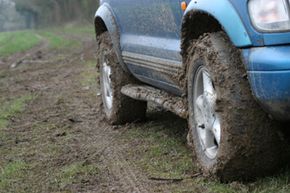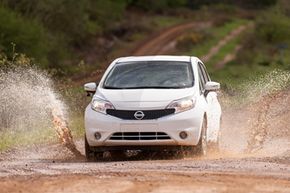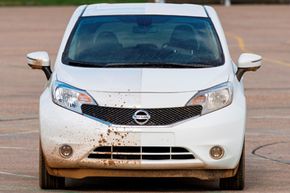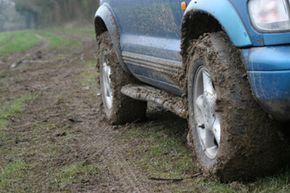\”

Next time you get in your car, take a quick look at the front end. Unless it\’s been washed very recently, chances are it\’s covered in bird poop, pollen dust, the remnants of high-speed insect collisions, or, at best, stains and spots from dirty acid rain. Sorry about that.
Traditional paints lack the ability to repel dirt and other contaminants, which leads to the dirt and dullness that we see on practically every coated surface. But in the near future, new cars might come equipped with a new type of finish that\’s designed to keep road debris, oil, gunk and even water from sticking to and drying on the paint\’s surface. This new coating, called self-cleaning paint, is hydrophobic, which means it repels water, and oleophobic, which means it repels oil. Not only will these specially painted cars look better on a day-to-day basis, they\’ll also be protected longer from some of the general, long-term wear and tear that occurs when the car\’s outermost paint layers eventually degrade from environmental damage. Contaminants like bird droppings and acid rain can build-up and weaken the clear coat and paint layers, which can eventually make the car\’s underlying metal surfaces more susceptible to rust and other damage. The new self-cleaning paint, however, aims to reduce the impact of such damage.
Eager to get your hands on a new car with self-cleaning paint? Well, the bad news is that they\’re not ready — not yet, anyway. But we\’re going to take a closer look at what inspired this new automotive finish, the technology that makes it possible, and what else has to happen before it\’s ready for prime time. The paint was developed at the Nissan Technical Centre in the United Kingdom in conjunction with a nanotechnology firm called Nano Labs. Nissan has to thoroughly test the paint before it gets the official approval to be applied to new cars, so researchers at the brand\’s testing facility in England will spend the summer of 2014 studying how the self-cleaning paint holds up on a Nissan Versa Note.
Nano-what?


As we mentioned, it takes some specialized knowledge to create a coating that can repel environmental contaminants. In tech circles, this paint is known as a nano-coating, and it\’s just one of many products that are the result of nanotechnology. Nanotechnology is an entire industry that revolves around the study of (and engineering of) nanoparticles, which are particles of elements that are so small, they have to be created in a lab. Once these nanoparticles are created, they have some really unique properties — especially in terms of how they react with ordinary particles. They\’ve been used to create clothing that can reduce air pollution on contact, and they\’ve even been added to products like sunscreen.
Nissan is the first auto manufacturer to put a nano-coating on a car, though, and they went straight to the source. The car company worked directly with Nano Labs, which was the first manufacturer to use nanotechnology to create a self-cleaning paint. Nano Labs has only been around since October of 2012, but it already has plenty of experience with the relatively new technology. The automotive version of the paint is called Ultra-Ever Dry, and it\’s based on coatings that are sold for industrial and commercial uses. Other versions of this industrial coating — those made by other manufacturers — were inspired by the leaf of the lotus plant, which has a surface that sheds dirt along with rainwater. This is where nanotechnology comes in — the engineers who designed the paint figured out how to minimize the surface area where water and dirt cling, which helps the water and other contaminants run right off. Of course, this happens at a level that can\’t be seen, but the effects are definitely noticeable. If you want to get picky, a nano-coating isn\’t really self-cleaning. To be more accurate, it simply repels the types of contaminants that would make it need to be cleaned, like water and oil. On a building, graffiti is an obvious and common cause of frequent washing. On a car, it\’s more likely to be dirty rainwater, mud, or bird droppings. Nissan says that its water-repellent properties will prevent snow, ice and frost buildup by maintaining a layer of air between the top of the paint\’s surface and whatever touches it — and Nano Labs says that its nanotechnology approach yields a less expensive product than other coatings that rely on surface tension.
Can we just paint everything this way?


If you let your imagination run wild, it seems like this self-cleaning paint could be useful for all kinds of things. We\’ve already talked about how nano-coatings and other self-cleaning paints can be especially useful for chores such as property maintenance. A graffiti-repelling exterior paint could make a huge difference in a lot of urban landscapes, and highly-trafficked areas would stay a lot cleaner for a lot longer if only they didn\’t attract dirt and grime.
There are other benefits to nano-coatings, too. Nano Labs says the paint is eco-friendly and also helps materials perform better over time. In other words, the protective qualities of the Nano Labs coating helps prevent damage and degradation, so if you apply the paint to, say, a wooden fence, the wood underneath the paint will stay strong and functional longer than if it was finished with regular paint. Other, more specialized products are already on the market, and new ones will almost certainly be introduced as the technology becomes more advanced. For example, Rust-Oleum, a paint brand that offers a lot of special-purpose paints and coatings to regular consumers, offers a water-repellent spray paint.
As for the automotive industry, it\’s unclear whether nano-coatings will become a commonplace offering, or if it\’ll remain exclusive to a single manufacturer for the time being. We won\’t really know more until Nissan completes its testing in the United Kingdom. Nissan eventually plans to make the paint available across its model range; but, at least for now, it\’ll be an option rather than a standard feature [source: Lingeman]. The industrial version of the paint can be manufactured in almost any color, and can also be matched to existing colors, although it\’s not yet clear if Nissan\’s automotive version will be quite as versatile. If automotive self-cleaning paint is a success, someday we might see a lot less bird poop on a lot more cars.
Lots More Information
Author\’s Note: How Self-Cleaning Paint Works
I enjoyed washing my cars, but I\’m kind of weird like that. And even the most enthusiastic DIY detailer doesn\’t want to touch a car covered in bird poop. But the most intriguing potential for this new paint? If it really does prevent snow and ice buildup, as Nissan claims — well, that\’s pretty remarkable. It seems like an unlikely possibility (considering the too-recent memories of our frigid winter) that a paint can prevent cold water from freezing to a cold car. But, we\’ll see.
Related Articles
- Can clothing neutralize pollution?
- How Automotive Finishing Works
- How Car Washes Work
- How Stock Car Painting Works
- How to Match Auto Paint
- Should You Wash Your Car Naturally With Rain?
Sources
- Golson, Jordan. "RIP, Car Washes: See Nissan\’s New Self-Cleaning Paint in Action." Wired. April 28, 2014. (June 16, 2014) http://www.wired.com/2014/04/self-washing-car/
- Hamamoto, Michael. "Nissan Testing \’Self-Cleaning\’ Car Through the Use of Oleophobic Paint." April 25, 2014. (June 16, 2014) http://www.dailytech.com/Nissan+Testing+SelfCleaning+Car+Through+the+Use+of+Oleophobic+Paint/article34796.htm
- Lingeman, Jake. "Nissan testing self-cleaning paint that repels water and dirt." Autoweek. April 25, 2014. (June 16, 2014) http://www.autoweek.com/article/20140425/carnews/140429904
- Nano Labs. "Nano Labs Announces New Technology in Self-Cleaning Paint." May 6, 2013. (June 16, 2014) http://nanolabs.us/press-releases/nano-labs-announces-new-technology-in-self-cleaning-paint/
- Preston, Benjamin. "Nissan Tests Self-Cleaning Car." The New York Times. May 2, 2014. (June 16, 2014) http://www.nytimes.com/2014/05/03/automobiles/nissan-tests-self-cleaning-car.html
- Sto Corp. "StoCoat Lotusan Coating for Exterior EIFS Stucco & Concrete." (June 16, 2014) http://www.stocorp.com/index.php/component/option,com_catalog2/Itemid,196/catID,43/catLevel,5/lang,en/productID,34/subCatID,44/subCatIDBP,44/subCatIDnext,0/












